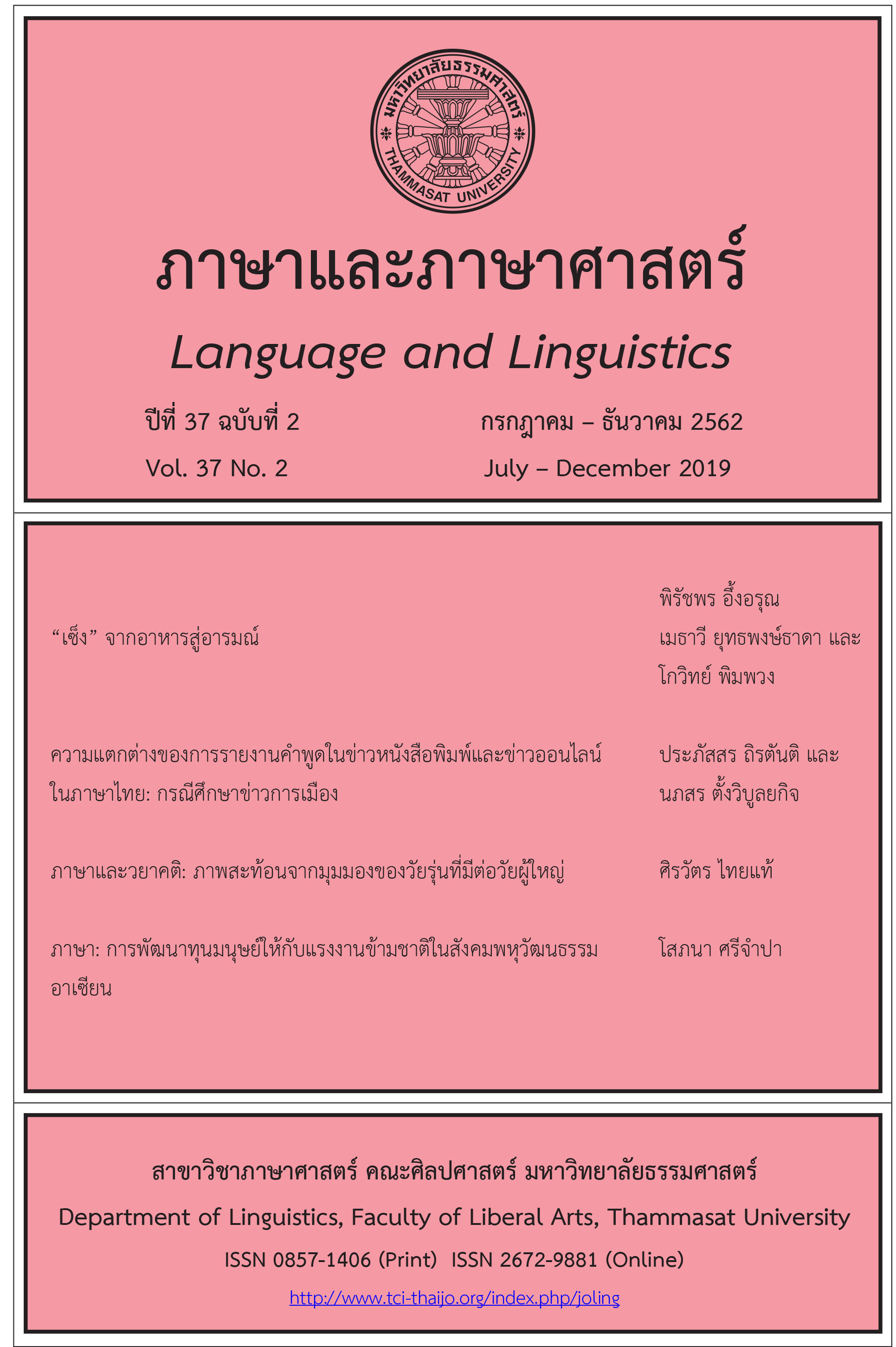Language: Human Capital Empowerment for Migrant Workers in the ASEAN Multicultural Society
Main Article Content
Abstract
The purpose of this research paper is to examine how Thailand, Malaysia and Singapore have contributed to the empowerment of migrant workers as human capital in multicultural ASEAN society. Data were collected through interviews as well as questionnaires. Research sites are as follows: In Thailand, Samut Sakhon Province; in Malaysia, Kuala Lumpur, Putrajaya and Jahor; and also in Singapore. The findings reveal that the social setting in which the migrant workers used language is an important factor. As for the workplace, the language used by migrant workers in Thailand include Thai, Burmese and Mon. In Malaysia, unskilled workers use mainly Malaysian, but also English, Chinese and Tamil, depending on the employer, and in Singapore, semi-skilled workers primarily use English. The use of Mandarin Chinese depends on the needs of the employer. Concerning educational institutions, Thai, Burmese, Mon and English are used in Thailand, English, Malaysian, Chinese and Tamil in Malaysia, and English. Chinese and the mother tongue of workers is used in Singapore. In Thailand, Thai and Burmese are used in government offices and public areas as well as some English. In Malaysia, English and Malaysian are used with Tamil, Hindi and Chinese also common, depending on the employer. In Singapore, they mainly used Tamil, and Hindi, but Chinese was also common, depending on the needs of the employer. In religious places, in Samut Sakhon, Thai temples use Thai, Mon, Burmese and Pali whereas in Malaysia and Singapore, Thai, English and Pali languages are more common in Thai temples. Concerning hospitals, Burmese-Thai interpreters are used in Thailand, and in Malaysia, English and Malaysian languages are preferred. In Singapore, doctors prefer English, but where there is a Thai nurse and doctor available, Thai is used.
Based on the results of the research, the following suggestions are made: stakeholders should collaborate to promote standardized interpretation services that are readily available as required. Thai students should be encouraged to study neighboring languages in ASEAN in order to serve as interpreters and translators on demand and compensated through a salary top-up. Migrant workers from the source country should be offered short-term orientation courses covering language, culture and basic regulations prior to commencing work in Thailand. The agencies concerned should train and harmonize the standard of services provided by Thai restaurant workers in Tom Yam Kung restaurants and in Thai spa and massage parlors, including classes in English conversation and in the languages of destination countries. The government should compile a database of Thai workers returning from other developed countries with a knowledge management system for developing work and language manuals that are available both offline and online.
Article Details
บทความทุกบทความเป็นลิขสิทธิ์ของภาษาและภาษาศาสตร์
References
ผลงานนำเสนอในการประชุม Research University Network ASEAN จุฬาลงกรณ์มหาวิทยาลัย, กรงเทพฯ.
ธนิต โสรัตน์. (2560). อุตสาหกรรม 4.0…การปฏิวัติอุตสาหกรรมใหม่แห่งอนาคต. สืบค้นจาก http://www.tanitsorat.com/file/
อุตสาหกรรม%20 4.0...การปฏิวัติอุตสาหกรรมใหม่แห่งอนาคต.pdf
พิชาภพ พันธุ์แพ. (2552). การจัดการมิติต่างๆ ทางวัฒนธรรม. กรุงเทพฯ: สำนักพิมพ์แห่งจุฬาลงกรณ์มหาวิทยาลัย.
บุบผา อนันต์สุชาติกุล. (2554). โครงการรูปแบบและการจัดการศึกษาสำหรับทายาทรุ่นที่สองของผู้ย้ายถิ่นจากประเทศพม่า (รายงาน
การวิจัย). กรุงเทพฯ: สำนักงานกองทุนสนับสนุนการวิจัย.
ประไพทิพย์ ลือพงษ์. (2555). การพัฒนาทุนมนุษย์ให้มีสมรรถนะความสามารถในการแข่งขัน. วารสารนักบริหาร, 32(4), 103-108.
พิมพ์พร หลักเพ็ชร์. (2559). ทิศทางแรงงานในอาเซียนหลังเปิดเออีซี Industry Focus. สืบค้นจาก
http://www.fti.or.th/2016/download/technical/Industry_
Focus_Vol.059_(%E0%B8%81.%E0%B8%84.59)_916.pdf
ลัดดาวัลย์ หลักแก้ว. (2561). สิทธิขั้นพื้นฐานที่หายไปของเด็ก...ลูกแรงงานข้ามชาติ.
ไทยโพสต์, สืบค้นจาก https://www.ryt9.com/s/tpd/2883642
ศิรภัสสรศ์ วงศ์ทองดี. (2557). การพัฒนาทรัพยากรมนุษย์ (พิมพ์ครั้งที่ 2). กรุงเทพฯ: จุฬาลงกรณ์มหาวิทยาลัย.
อำไพ ศรีเริงหล้า. (2559). นโยบายและทิศทางการพัฒนางานสิทธิมนุษยชนตามภารกิจของกระทรวงแรงงาน. รายงานสรุปผลการ
ประชุมเชิงปฏิบัติการ “การพัฒนางานแผนสิทธิมนุษยชนของกระทรวงแรงงาน” (น. 5-45). กรุงเทพฯ: กองส่งเสริมสิทธิและ
เสรีภาพ กรมคุ้มครองสิทธิและเสรีภาพ.
Anirut, J. (2561). ค่าแรงของ 10 ประเทศ AEC. สืบค้นจาก https://www.smartsme.co.th /content/110109.
Ethnologie, Languages of the world. (n.d.). Brunei. Retrieved September, 6, 2019, from https://www.ethnologue.com/country/BN.
. (n.d.). Cambodia. Retrieved September 6, 2019, from https://www.ethnologue.com/country/KH.
. (n.d.). Indonesia. Retrieved September 6, 2019, from https://www.ethnologue.com/country/ID.
. (n.d.). Laos. Retrieved September 6, 2019, from https://www.ethnologue.com/country/LA.
. (n.d.). Malaysia. Retrieved September 6, 2019, from https://www.ethnologue.com/country/MY.
. (n.d.). Myanmar. Retrieved September 6, 2019, from https://www.ethnologue.com/country/MM.
. (n.d.). Philippines. Retrieved September 6, 2019, from https://www.ethnologue.com/country/PH.
. (n.d.). Singapore. Retrieved September, 6, 2019 from https://www.ethnologue.com/country/SG.
. (n.d.). Thailand. Retrieved September 6, 2019, from https://www.ethnologue.com/country/TH.
. (n.d.). Viet nam. Retrieved September 6, 2019, from https://www.ethnologue.com/country/VN.
Nye, J. S. Jr. (2004). Soft power: The means to success in world politics. New York, NY: Public Affairs.
Park, Won Joo. (2004). Human capital & Economic growth in Japan. Institute of Developing Economies: Japan External
Trade Organization.
Rouijel, E. (2010, Demcember 6). Sociolinguistics: William Labov [Video file]. Retrieved from
https://www.slideshare.net/hassanrouijel/william-labovs-contribution-to-linguistics
Worldometers. (2019). Brunei Population. Retrieved March 14, 2019, from https://www.worldometers.info/world-
population/brunei-darussalam-population/
. (2019). Cambodia Population. Retrieved March 14, 2019, from https://www.worldometers.info/world-
population/cambodia-population/
. (2019). Indonesia Population. Retrieved November 20, 2019, from https://www.worldometers.info/world-
population/indonesia-population/
. (2019). Laos Population. Retrieved March 14, 2019, from https://www.worldometers.info/world-population/laos-
population/
. (2019). Malaysia Population. Retrieved March 14, 2019, from https://www.worldometers.info/world-
population/malaysia-population/
. (2019). Myanmar Population. Retrieved November, 20, 2019, from https://www.worldometers.info/world-
population/myanmar-population/
. (2019). Philippines Population. Retrieved March, 14, 2019, from https://www.worldometers.info/world-
population/philippines-population/
. (2019). Singapore Population. Retrieved March, 14, 2019, from https://www.worldometers.info/world-
population/singapore-population/
. (2019). Thailand Population. Retrieved March, 14, 2019, from https://www.worldometers.info/world-
population/thailand-population/
. (2019). Vietnam Population. Retrieved March, 14, 2019, from https://www.worldometers.info/world-
population/vietnam-population/


